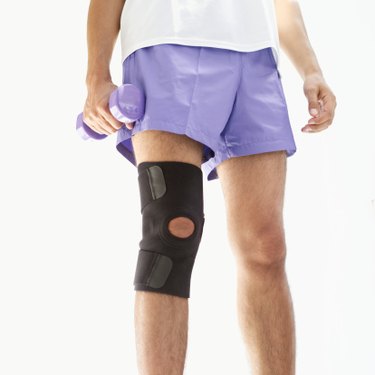
Hypermobility in your knees can be due to injuries such as ligament sprains or connective tissue diseases like benign hypermobility syndrome. In either case, strengthening and developing the muscles around your knees is imperative to managing hypermobility. Before starting a new exercise program, consult your physician.
Bridges and Straight-Leg Raises
Video of the Day
Non-weight-bearing exercises place less strain on your knees and therefore are a good starting point. Bridges are performed lying on your back with your knees bent and feet on the floor. Slowly lift your hips up off the floor, squeezing your hamstring and gluteus muscles. Straight leg raises target your thigh or quadriceps muscles and are performed lying on your back with your legs straight. Slowly lift one leg up approximately 8 inches off the floor and hold for five to 10 seconds. Perform one to three sets of 10 to 20 repetitions between three and five days a week.
Video of the Day
Knee Extension and Flexion
Knee extension and flexion on resistance machines isolate your quadriceps and hamstring muscles, respectively. Resistance machines also keep movements in one direction, reducing your risk of injury or pain. As your strength improves, you may increase the resistance, sets or repetitions. However, do not increase the resistance on one exercise and not another. This could lead to strength imbalances and more instability. Perform one to three sets of 10 to 20 repetitions, two to three days a week.
Squats and Lunges
Squats and lunges improve muscle strength, stabilization and coordination between muscle groups. Proper squat technique starts with standing with your feet hip-width to shoulder-width apart. Slowly push your hips back and lower yourself down until your knees are bent at 90-degree angles. When you return to the start position, make sure not to lock your knees. Instead, keep them slightly flexed or bent, recommends the Cleveland Clinic.
Lunges are performed in a staggered stance with your weight on your back toe and front heel. Slowly lunge forward, bending your front knee until it is at a 90-degree angle. With squats and lunges, your torso will lean slightly forward, but your back should remain straight and not rounded. Perform one to three sets of 10 to 20 repetitions two to three times a week.
Single-Leg Balance
Improving your balance and joint stability can reduce the wear and tear on your knees and decrease pain. To start, perform single-leg balance on the floor while holding onto a countertop or chair for support. Keep the knee of your weight-bearing leg slightly bent as well. As single-leg balance becomes easier, take your hand off the chair or countertop. Other progressions include closing your eyes, standing on a pillow or wobble board and performing movements with your non-weight-bearing leg such as hip abduction. Hold single-leg balance for 30 to 60 seconds and repeat two to three times daily.
- Cleveland Clinic: Benign Hypermobility Syndrome
- “The Journal of The American Osteopathic Association”; Benign Joint Hypermobility Syndrome: Evaluation, Diagnosis and Management; Michael R. Simpson, D.O.; September 2006
- Summit Medical Group: Lateral Collateral Ligament Sprain Rehabilitation Exercises